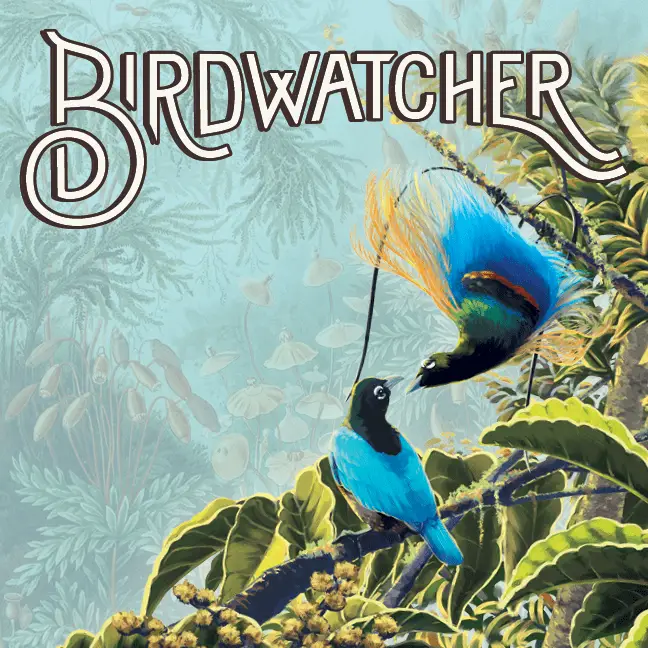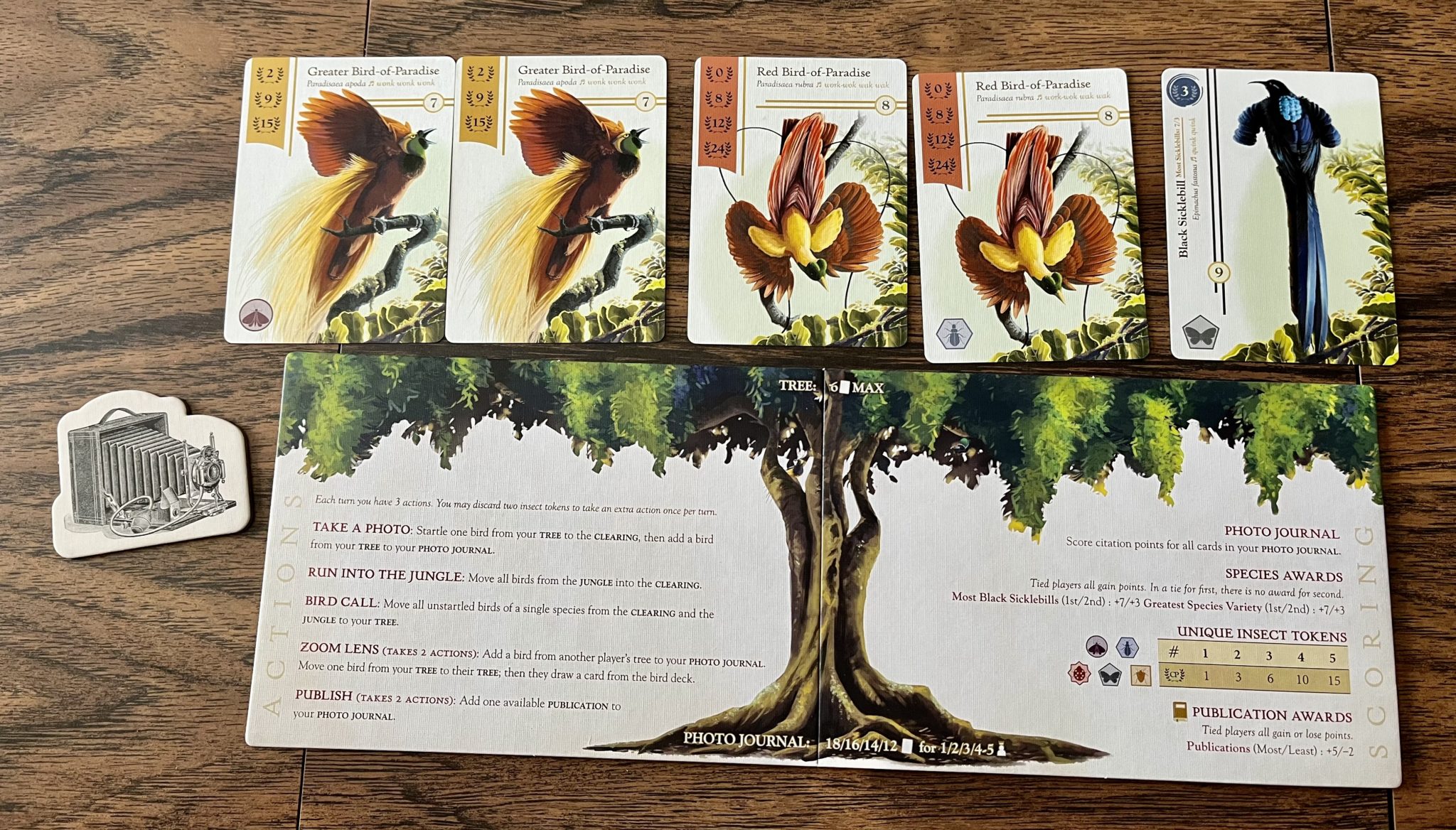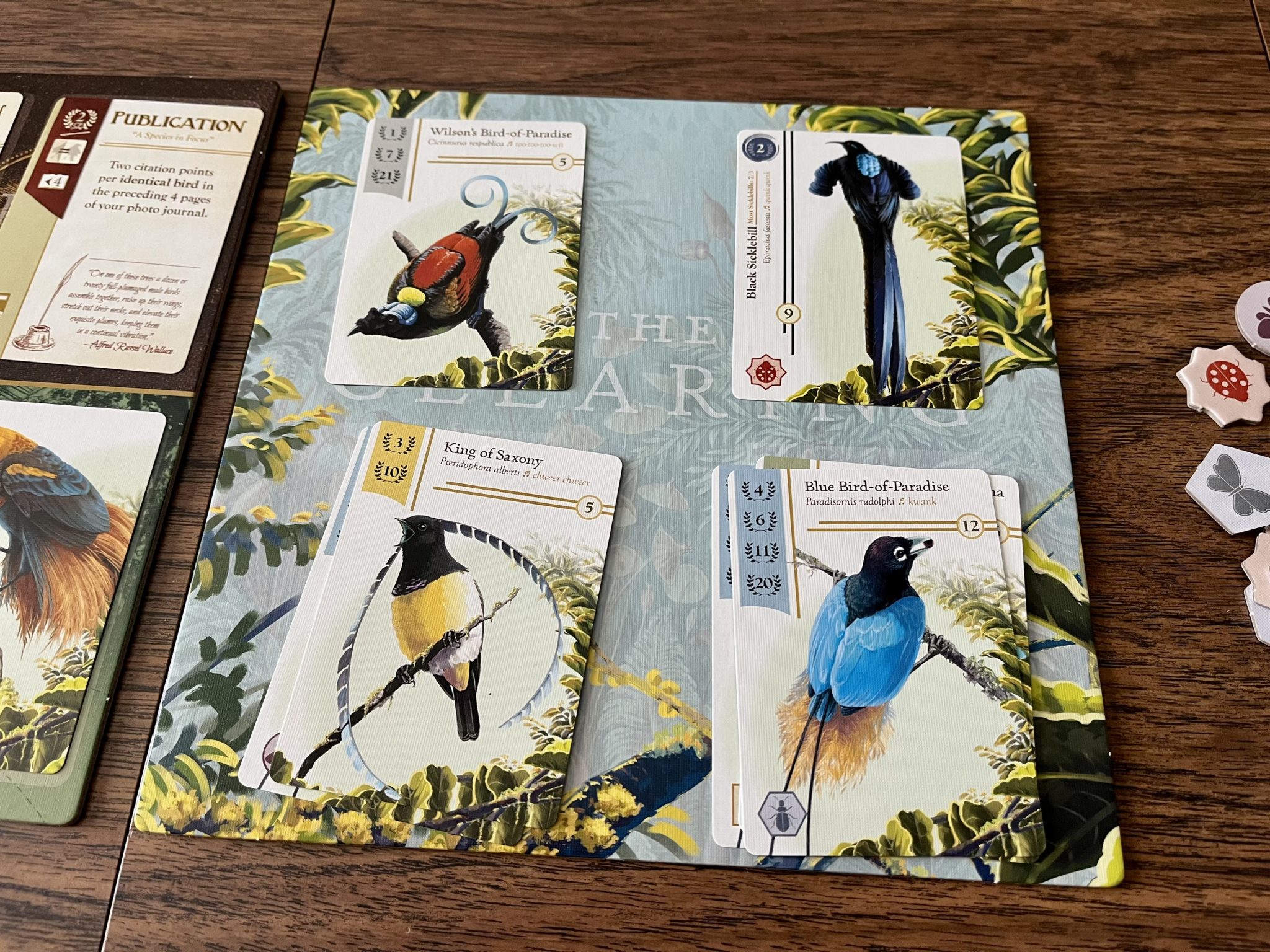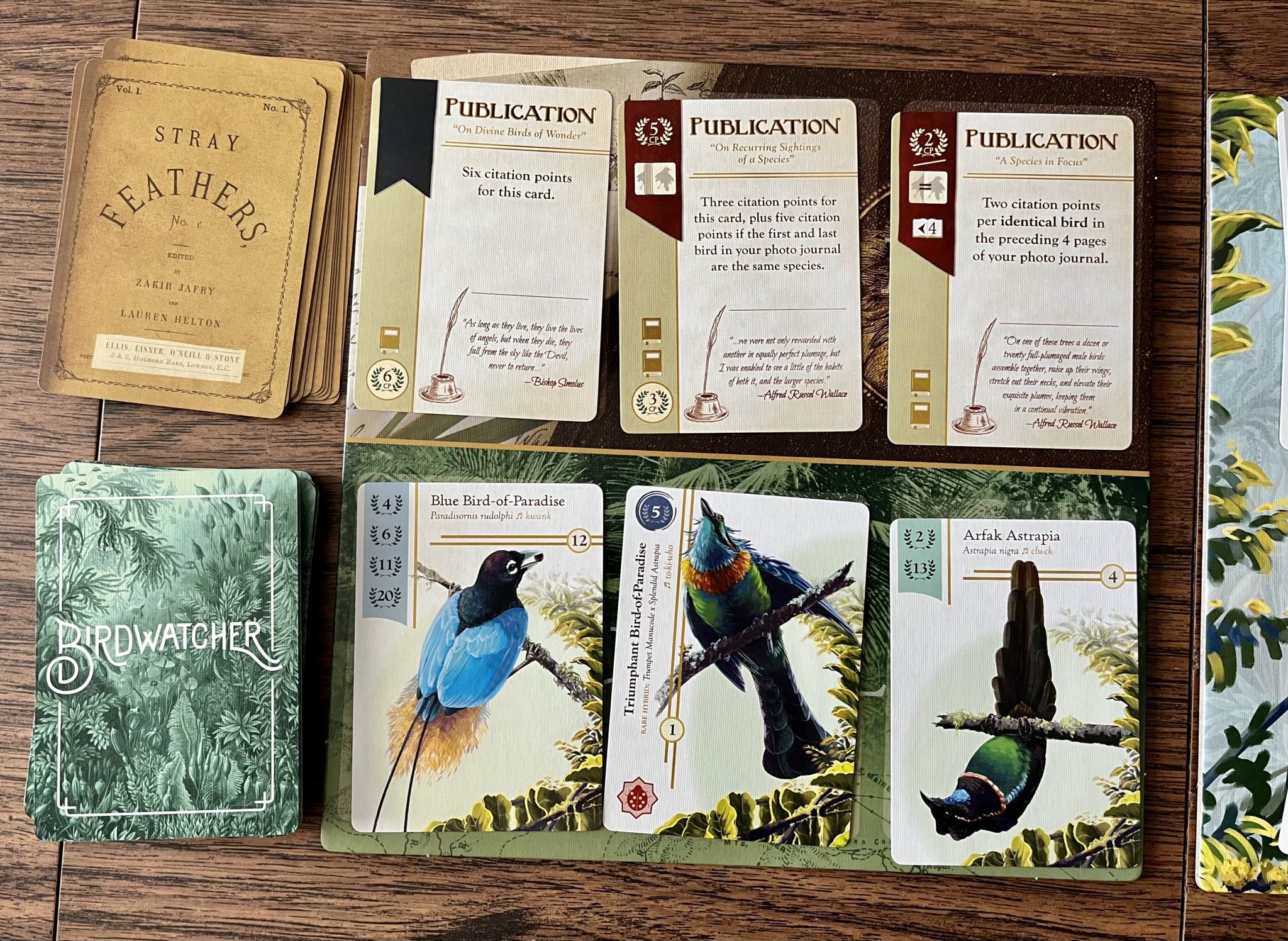Birdwatcher is a set collection hand management game where you are taking pictures of birds. It’s a fast playing strategic and competitive game that can be played with your family or game group. The game has been well receive and liked by many including me and my family. The game takes about 30-45 minutes to play and can be played by 1-5 players. The game is designed by first time designer Zakir Jafry and published by Oni Games and Renegade Game Studios who were nice enough to send me a copy for review. Renegade has been on fire lately with games like My Father’s Work, they picked up Crusaders: They Will be Done, Artisans of Splendent Vale, and extending their Architects of the West Kingdom line. Birdwatcher is a great addition for any home. Continue reading to see why.

What’s in the Box?
- 69 Bird cards
- 10 Special bird cards
- 12 Twelve-wired bird-of-paradise cards
- 19 Publication cards
- 3 Solo mode cards
- 1 Camera token
- 30 Insect tokens
- 2 Central boards
- 1 Scorepad
- 5 Player Trees
- 1 Rulebook

How’s it Play?
Players take turns performing 3 actions on their turn to take pictures of birds and add them to their journal. Cards start out in the jungle, but then move from player’s trees, to the clearing, and possible all around those until a player decides to take a picture of it to then be placed in a player’s photo journal.
Birds can be scored in different ways, but most of the birds score when you collect a specific number of that bird to score more points. On each card the points are listed on the top left of that card. The banner shows the number of points you earn for the number of same birds you place in a row on your photo journal. Some birds score a flat number of points by itself without needing to be placed in a set in your photo journal.

In board game terms, this is a set collection game with some other fun mechanics to find ways to find more birds of a specific type that matches what type of birds you are looking for. Players all start with a tree board with 4 random starting birds. There are 5 main actions you can take, and each player spends 3 actions on their turns doing any of the 5 actions. Some of these actions cost 1 action to perform while others require 2 actions to perform.
1. Take a photo of a bird in your tree
To do this, you first startle a bird in your tree due to the sound from the camera. So you take a bird card from your tree and place it in the clearing, a spot for birds that fly away from any player’s tree. This bird is startled and is tapped on its side. Then the player adds a bird from their tree to their photo journal. The card is always added to the right of all other cards placed in the photo journal at that time. Then, if the bird has an insect token on the bottom left of its card, you collect the matching insect as well.

2. Perform a bird call
You choose one specific species and add all of the visible birds of that type that are NOT startled in the jungle and also in the clearing, and move them to your tree. You only add cards that are visible, so when cards eventually are placed on top of other cards in the clearing, they will be off limits unless the card on top is taken, then the uncovered card is now available. If a card was taken from the jungle, that slot is immediately refilled with a new card from the deck. Each player’s tree can only have a maximum of 6 birds total.

3. Run into the jungle
Place all 3 cards visible cards in the jungle in any 3 separate spaces in the clearing, then flip over 3 new cards from the deck filling in the 3 new slots in the jungle. Birds placed in the clearing this way do not become startled, and are still available to be called this turn.

4. Zoom lens (takes 2 actions)
You take a photo of a bird in another player’s tree. You may only choose this activity if you have at least one bird in your tree because you take that bird from the other player’s tree to place in your photo journal, place 1 bird from your tree and move it to their tree, and then they draw the top card from the deck to also add to their tree.

5. Publish
Place an available publication card into your photo journal. Replace the card you took with a new card from the publication deck. These cards give you points if you accomplish its goal. But beware because a publication care ends any preceding set.

Players then take turns doing these actions. New cards come out, players find sets of birds they want to start collecting by taking photos of those birds, and will also be discarding more birds to the clearing. This gives players more choices of birds as well. The game ends when a player reaches a set number of cards in their photo journal according to the player count, or a player needs to draw a card from the bird deck and there are no cards left.
Players continue with each player having the same number of turns and then final scoring is done. Players gain points from their photo journal according to the sets shown on their bird cards and their publication cards. Black Sicklebills score their own individual points, but also the player who has the most in their photo journal scores an extra 7 points and second most scores 3 points. The player with the most variety of birds scores 7 points and second most scores 3 points. When still playing the game, a player can spend 2 insects to take an additional turn, or at the end of the game they convert them into groups of unique tokens and gain points for those as well. Publication cards have books listed on them, and the player with the most book icons scores 5 extra points, with the player who has the fewest scoring -2 points. The player with the most points wins the game.

The Verdict
We absolutely loved playing this game and I believe will keep enjoying it for the future. Not only is the theme easy to get into and makes sense with the mechanics of the game, but my daughter just loves birds and gets her binoculars out regularly to bird watch.
So, why is the game good? Well, players are looking for sets of birds, and each species rewards points differently. You are comparing getting 2 of the same species of 11 points versus getting 4 of the same bird for 20 points. And that’s only two examples, you will be faced with far more types of species to choose from. Many times, you start with whatever birds you see multiples of. But with time, you form a strategy by looking at possible publications to help, or by weighing insects to gain those points at the end of the game. Also, you want to watch what other players do as you can gain extra points for having the most Sicklebills or the most variety of birds, or the most books.
The game requires players to continue finding similar species of birds, and the game helps with this because to put a bird in your photo journal, you have to place one in the clearing. Birds are always cycling through, and players many times place birds in their trees solely to return them back to the clearing. This cycling of cards really helps all players see more birds to claim. In addition there is always a way to take a picture of a bird on another player’s tree, you just have to reward that player with possibly something better.

The game requires sets of birds, but also players should perform their actions to take advantage of what the setup is at that time. If there are 2 or 3 similar birds you might want to do a bird call and gain those birds to your tree solely to use them for payment to add other birds to your photo journal.
In addition to taking the best actions, there are special birds that come out that reward more points for its rarity on its own. Or other cards mimic the card previous to it, helping you complete a set more easily.
Players choose a species to add to their photo journal and also seeing what others wants at that time. With time, this will change and players will want other different cards, but players can watch to see when it might be a good time to go after a certain species, or grab a bird just so another player has to use their lens to take a picture of it from your tree, and you gain 2 other cards because of that.
The game is pretty straight forward, but the timing on what you add and how you do it forms the strategy for playing the game. I have tried to math out my options so that I can score at least 5 points per card. If that’s not possible, I will most likely try something else. Also weighing in the end game scoring majorities is important and always keeping an eye on the 3 open publications. Lastly, don’t underestimate the insects. A player can add the insect strategy with their sets to be rewarded for a unique set of those in addition at the end of the game that can surprise other players.

Ultimately we will continue to watch birds in the jungle as well as from the clearing in hopes to attract them to our trees to add to our photo journal. Birdwatcher will find a lot of time on our table as it’s accessible to younger players, its strategic, it plays in a good amount of time, and has a great theme for us.
Images via Renegade Games
Have strong thoughts about this piece you need to share? Or maybe there’s something else on your mind you’re wanting to talk about with fellow Fandomentals? Head on over to our Community server to join in the conversation!

